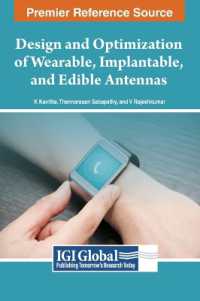Description
The most comprehensive, multi-disciplinary text in the field, Cummings Otolaryngology: Head and Neck Surgery, 7th Edition, provides detailed, practical answers and easily accessible clinical content on the complex issues that arise for otolaryngologists at all levels, across all subspecialties. This award-winning text is a one-stop reference for all stages of your career—from residency and board certification through the challenges faced in daily clinical practice. Updated content, new otology editor Dr. Howard W. Francis, and new chapters and videos ensure that this 7th Edition remains the definitive reference in today's otolaryngology.- Brings you up to date with the latest minimally invasive procedures, recent changes in rhinology, and new techniques and technologies that are shaping patient outcomes.- Contains 12 new chapters, including Chronic Rhinosinusitis, Facial Pain, Geriatric Otology, Middle Ear Endoscopic Surgery, Pediatric Speech Disorders, Pediatric Cochlear Implantation, Tongue-Ties and Lip Ties, Laryngotracheal Clefts, and more.- Covers recent advances and new approaches such as the Draf III procedure for CRS affecting the frontal recess, endoscopic vidian and posterior nasal neurectomy for non-allergic rhinitis, and endoscopic approaches for sinonasal and orbital tumors, both extra- and intraconal.- Provides access to 70 key indicator (Accreditation Council for Graduate Medical Education Key Indicator Procedures), and surgical videos – an increase of 43% over the previous edition.- Offers outstanding visual support with 4,000 high-quality images and hundreds of quick-reference tables and boxes.- Enhanced eBook version included with purchase. Your enhanced eBook allows you to access all of the text, figures, and references from the book on a variety of devices.
Table of Contents
Flint: CUMMINGS OTOLARYNGOLOGY, 7ePrefacePart I: Measuring Outcomes and Performance1. Outcomes Research 2. Interpreting Medical Data3. Evidence-Based Performance MeasurementPart II: General Otolaryngology4. History, Physical Examination, and the Preoperative Evaluation5. General Considerations of Anesthesia and Management of the Difficult Airway6. Surgical Management of the Difficult Adult Airway7. Tracheotomy 8. Overview of Diagnostic Imaging of the Head and Neck9. Deep Neck and Odontogenic Infections10. Head and Neck Manifestations in the Immunocompromised Host11. Laryngeal and Tracheal Manifestations of Systemic Disease12. Oral Manifestations of Systemic Diseases 13. Otolaryngology in the Elderly14. Pain Management in the Head and Neck Patient15. Sleep Apnea and Sleep DisordersPart III: Facial Plastic and Reconstructive SurgerySection 1: Facial Surgery16. Aesthetic Facial Analysis17. Recognition and Treatment of Skin Lesions18. Scar Revision, Keloids, and Camouflage19. Facial Trauma: Soft Tissue Lacerations and Burns20. Maxillofacial Trauma21. Reconstruction of Facial Defects22. Hair Restoration: Medical and Surgical Techniques23. Management of Aging Skin24. Rhytidectomy and Facial Liposuction25. The Aesthetic Brow and Forehead26. Blepharoplasty27. Mentoplasty28. OtoplastySection 2: Rhinoplasty29. The Nasal Septum30. Nasal Fractures31. Rhinoplasty32. Special Rhinoplasty Techniques33. Non-Caucasian Rhinoplasty34. Revision RhinoplastyPart IV: Sinus, Rhinology and Allergy/Immunology35. Allergy and Immunology of the Upper Airway36. Olfactory function and dysfunction37. Objective Assessment of Nasal Function38. Imaging of Nose and Sinuses39. Non-allergic Rhinitis40. Acute Rhinosinusitis: Pathogenesis, Treatment and Complications41. Pathogenesis of Chronic Rhinosinusitis42. Chronic Rhinosinusitis: Evidence based Medical Treatment43. Chronic Rhinosinusitis: Outcomes of Medical and Surgical Treatment44. Primary Sinus Surgery45. Causes of Failure, Revision Surgery for Rhinosinusitis, and Management of Complications in Endoscopic Sinus Surgery46. Management of the Frontal Sinuses47. Epistaxis48. Cerebrospinal Fluid Rhinorrhea49. Sino-orbital Interface50. Benign Tumors of the Sinonasal Tract51. Systemic Disease of the Nose and Sinuses52. Facial PainPart V: Laryngology and Bronchoesophagology53. Laryngeal and Pharyngeal Function54. Visual Documentation of the Larynx55. Voice Evaluation and Therapy56. Neurologic Evaluation of the Larynx and Pharynx57. Neurologic Disorders of the Larynx58. The Professional Voice59. Laser Surgery: Basic Principles and Safety Considerations60. Benign Vocal Fold Mucosal Disorders61. Acute and Chronic Laryngopharyngitis62. Medialization Thyroplasty63. Arytenoid Adduction and Abduction64. Laryngeal Reinnervation65. Chronic Aspiration66. Laryngeal and Esophageal Trauma67. Surgical Management of Upper Airway Stenosis68. Diseases of the Esophagus69. Transnasal Esophagoscopy70. Zenker Diverticulum71. Tracheobronchial EndoscopyPart VI: Head and Neck Surgery and OncologySection 1: General Considerations72. Fundamentals of Molecular Biology and Gene Therapy73. Biology of Head and Neck Cancers74. Human Papillomavirus (HPV) and the Epidemiology of Head and Neck Cancer75. Radiotherapy for Head and Neck Cancer: Radiation Physics, Radiobiology, and Clinical Principles76. Chemotherapy and Targeted Biologic Agents for Head and Neck Cancer77. Skin Flap Physiology and Wound Healing78. Free Tissue Transfer79. Integrating Palliative and Curative Care Strategies in the Practice of Otolaryngology80. The Management of Cutaneous Head and Neck MelanomaSection 2: Salivary Glands81. Physiology of the Salivary Glands82. Diagnostic Imaging and Fine-needle Aspiration of the Salivary Glands83. Inflammatory Disorders of the Salivary Glands84. Benign Neoplasms of the Salivary Glands85.







